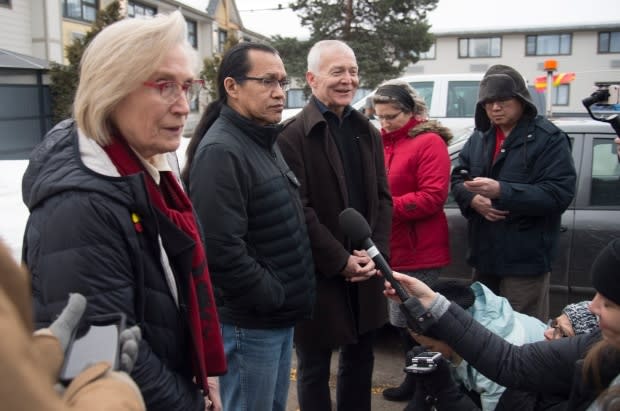Wet'suwet'en, B.C. and Canada sign MOU on negotiations for legal recognition of title
Hereditary chiefs of the Wet'suwet'en Nation have signed a memorandum of understanding with B.C. and Canada that sets the path for negotiations on legal recognition of their title to 22,000 square kilometres of traditional territory.
"It was very emotional for all of the hereditary chiefs because we all remember what our elders who have passed on said. We all know that this was their goal," said Tsayu clan chief Na'moks, who was part of the videoconference signing event on Thursday.
Effective immediately, the MOU commits Canada and B.C. to recognize that rights and title are held by house groups within the Wet'suwet'en Nation, "under their system of governance."
The Wet'suwet'en governance system, which pre-dates Canada, is rooted in the feast hall and organized around a clan and house system in which different house groups hold authority over specific sections of territory.
The MOU signing comes 23 years after the Supreme Court of Canada ruled on the Delgamuukw-Gisday'wa case brought forward by Gitxsan and Wet'suwe'ten hereditary chiefs who were seeking recognition of ownership and jurisdiction over their respective territories.
The Supreme Court concluded that Aboriginal title had not been extinguished when the region became part of Canada but did not actually legally recognize the nations' title — instead it ordered a new trial but also encouraged negotiation between the First Nations, B.C. and Canada.
For a period of time, the Wet'suwet'en pursued negotiations through the B.C. treaty process but withdrew from treaty talks several years ago. Now, they're coming back to the table with Canada and B.C. to negotiate once again.
Timeline 'not etched in stone'
The Wet'suwet'en Nation was divided into six band councils — governing systems from the Indian Act that were imposed on the Nation and physically separated people onto reserves spread out across hundreds of kilometres.
Four of the band council chiefs have already expressed opposition to the signing of the MOU and are calling for negotiations to be halted, writing in a public statement that they lack confidence in the process that's unfolding without their consent.
B.C. Minister of Indigenous Relations and Reconciliation Scott Fraser said that reunification within the Nation is an essential piece to moving forward with any kind of final agreement.
While most of that work will be left up to the Nation to figure out internally, he said the province will be engaging with the elected chiefs as well.
Within the MOU are timelines for next steps, though Fraser said those are not "etched in stone" and there will be flexibility from all parties involved.

The MOU states "There will be no impact on rights and interests pertaining to land until jurisdiction is transferred to the Wet'suwet'en." The MOU says transfer of jurisdiction will happen over time and jurisdiction may be shared in some cases with the federal and provincial governments.
Negotiating some of the areas of the MOU will likely take more time than others, like coming to agreement on where the Wet'suwet'en will have exclusive jurisdiction versus what will be shared.
Na'moks said some areas for shared jurisdiction might be easier to figure out, like maintenance of highways through the territory.
The agreement also doesn't make any impact on the Coastal GasLink pipeline that is currently under construction and which led to the MOU discussions in the first place.
Conflict over the pipeline project amplified the unresolved questions around title and jurisdiction on the Nation's traditional territory and also raised questions around which government (hereditary or band council) could consent to projects on the territory.
Addressing 'uncertainty and unpredictability'
Five of the six band councils signed benefit agreements with the pipeline company while hereditary leadership was opposed to the project and maintained that band council authority was limited to the reserve.
Fraser said the MOU should provide clarity on things like how the land will be managed and through which governing structure.
He said these are "outstanding questions" that have been ignored and as a consequence "have led to conflict and disagreement certainly on the ground."
"So our hope and the intent is… that we're going to start addressing that uncertainty and unpredictability on the land base for everybody."
The end goal of the MOU is to come to an agreement recognizing Wet'suwet'en rights and title that would be protected under Section 35 of the constitution.
But as Knedebeas, hereditary chief of the Unist'ot'en wrote in a news release on Thursday, "Signing this thing doesn't mean it's a done deal."
He added that "We need to participate in this to work, for all of us, for those yet to come."

